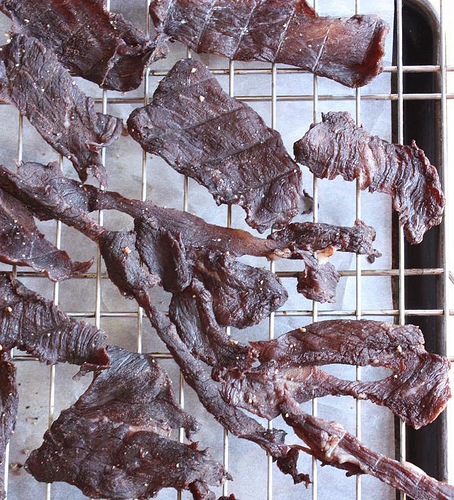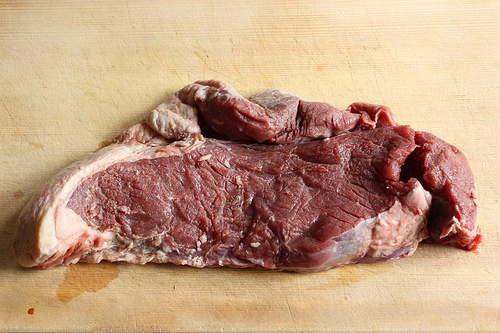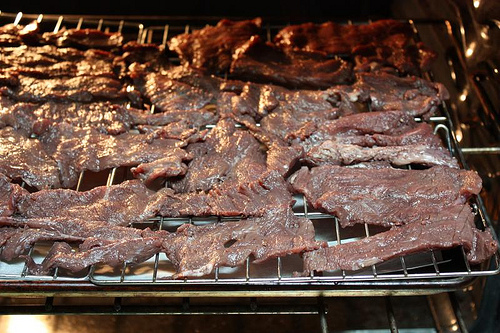
I like to occasionally make beef jerky because it always seems like the stuff sold at markets is pricey. Plus, there’s never enough to satisfy me. A while back, I made a Vietnamese-style lemongrass and chile jerky and used it for snacking and green papaya salads (goi du du). Most recently, I tried a jerky recipe that involved marinating the beef with red wine and fish sauce.
Yes, you read that right! But no, it wasn’t some kind of Vietnamese-French thing. The idea came by way of an enewsletter from Morris Grassfed Beef. I’ve been annually buying ¼ of a cow from Joe Morris for close to ten (10!) years. It’s through their CSA (Community Supported Agriculture) program. With about 80 pounds of meat a year, the quarter share, called a “split half,” is too much for our household. I split it with a friend.
The grass-fed beef goes into all kinds of foods. For example, Joe’s delicious ground beef is used for thit bo la lot (beef in betel leaf) and chuck steak gets featured in bo kho (beef stewed with tomato, lemongrass, and star anise). I order extra bags of fragrant bones for pho noodle soup.
Each year, as I try to empty the freezer to make room for the new stash (it comes in midsummer), there are always a few cuts lingering. This time around I found a piece of London broil. This isn’t of my favorite cuts because it is extra lean – which makes it perfect for jerky.

Joe and his staff must have read my mind as the latest Morris Grassfed Newsletter had a recipe for “Dan’s Oven Beef Jerky” that employed London broil! The folksy recipe belonged to a gentleman named Dan Dungy.
I loved reading Dan’s instructions, particularly when he describes that fish sauce is “readily found in the Asian food section of supermarkets in town.” As for the red wine, Dan called for “table wine or a bottle that has oxidized is fine as long as it hasn’t turned to vinegar.”
Moreover, his combination of the wine and fish sauce was framed as nothing special. That's quite an indication of how far Asian ingredients have gone in terms of becoming part of mainstream American cooking.
Dan's recipe was such a great use of whatever is at hand, that I had to try it. The results? Really good. In fact, my husband remarked, “This is kinda like old-fashioned American beef jerky from when I was a kid.” The flavor is deep and releases as you chew on the meat. There is a winey, savory quality that initially reminded me of gamier venison.
Morris grass-fed beef is 100% grass fed with no use of grain to fatten up the cows. The result is beef that changes with the annual rainfall. The flesh has actual taste. Dan’s use of red wine and fish sauce heightens the beefiness of Morris Grassfed meat. I added a healthy dose of black pepper to give a kick to the jerky.
If you have a favorite source for grass-fed beef, try it out. It’s sold at markets such as Whole Foods. If you don’t, no worries. Just use whatever London broil at your grocery store. Any other lean cut (read: you don’t see white marbling in the flesh) will work.
As for the wine, use one with big flavor, such as cabernet sauvignon, zinfandel, syrah, or a blend. My husband found a cheapie blend in the back corner of his “cellar” (a closet).
RECIPE
Red Wine and Fish Sauce Beef Jerky
This recipe calls for cutting the meat thicker than the Vietnamese jerky with lemongrass and chiles. With thicker slices, Dan uses lower heat and as a result, it requires several hours of low-heat baking. Adapted from original recipe by Dan Dungy.
Makes about 12 to 16 ounces
1 ½ to 2 pounds London broil
¾ to 1 cup hearty red wine
4 to 5 tablespoons fish sauce
½ to ¾ teaspoon black pepper
1. Trim all fat and connective tissue from meat. Slice the meat ⅛ to ¼ inch thick, making the pieces as big as you can. They don’t have to be perfect. Transfer the meat to a one-gallon zip-top bag.
2. Measure out the red wine and add fish sauce to taste. You want a savory back note but not too much. The flavor will concentrate down during the baking time. Add the pepper. Pour into the bag and use your hands combine the ingredients, making sure that the meat is well covered.
3. Seal the bag, squeezing out excess air. Put the bag in a bowl or on a plate. Refrigerate for 6 hours or overnight.
4. Position a rack in middle of the oven and preheat to 200F. Line a baking sheet with parchment or foil. Put 1 large or 2 medium cooling racks on top to promote heat circulation. It’s okay if the racks extend beyond the baking sheet. Aim to elevate the beef as much as possible.

5. Drain the meat in a colander. Blot excess moisture from each piece with paper towel. Arrange the beef flat atop the racks. They can touch but try not to overlap them much. 6. Bake with the oven door slightly open by about ¼ inch. Wedge a wooden spoon or some other nonflammable or breakable object between the door and oven.
Let the meat dry out for 3 to 4 hours, turning it midway, if you like. The meat is done when it feels dry to the touch but still somewhat soft. The pieces will be about 50% of their original sizes. Once done, remove from the oven and set aside to completely cool. Transfer to a zip-top bag and refrigerate or freeze.
Have you tried making jerky with red wine and/or fish sauce? How did you do it and what did you think of it?
Related posts:

















Belinda @zomppa says
I LOVE beef jerky - and the fish sauce adds the perfect touch. Nice job!
Suzanne says
Incredible! And gluten-free, too! (Most jerky is not, because of the soy sauce.) Thank you!
Bethany says
When my mom makes Lao style beef jerky, she insists on frying it after it's dried. We don't use fish sauce with beef. Apparently in Lao cuisine, fish sauce is reserved for chicken. She also told me jerky MUST be stored in glass jars at room temperature. My jerky actually grew mold the one time I didn't put it in a glass jar. The wisdom of Asian women.
Andrea Nguyen says
Suzanne: I never thought of it, but that is GF! Thanks.
Bethany: I guess the frying ensures the preservation. It's like double cooking. The oil must function like varnish to give a protective coating. Very funny about the glass jar. Do like Mama says.
Simon Bao says
Andrea, I'm never sure what to do with a cut of beef labeled "London Broil," so can you tell me which you may have used?
The meat in the photograph looks like it might be Top Round, which is often sold as or used for London Broil. The photo doesn't look like Flank Steak, although that's another cut that is often used for London Broil and also used for home-made jerky. (Somewhat expensive jerky.)
Doug Arn says
i tried making this a few weeks ago from a recipe I found in an old Vietnamese cookbook. Here's a tip: a nice Cabernet Sauvignon really enhances the flavour over simple cooking red wine! It really enhances the flavour of the beef jerky!!!
Doug
http://thewinespot.org/Red-wine.html
David Ng says
Never tried red wine jerky. Should really bring out the flavors.
Sodium lauryl sulfate says
Yemen's economy is weak compared to most countries in the Middle-East, mainly because Yemen has very small oil reserves. Yemen's economy depends heavily on the oil it produces, and its government receives the vast majority of its revenue from oil taxes. Thanks.
Canada Goose sale says
Nothing seek, nothing find.
Canada Goose Jackets says
Better late than never.
marlon says
The pieces will be about 50% of their original sizes. Once done, remove from the oven and set aside to completely cool.